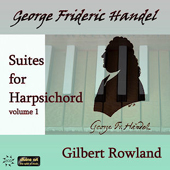
ESSENTIAL RECORDINGS

1- Suite in D minor, HWV 428
2- Suite in A major, HWV 454
3- Suite in E minor, HWV 438
4- Suite in C major, HWV 443
5- Suite in G minor, HWV 439
6- Suite in G major, HWV 441
7- Suite in E minor, HWV 429
8- Suite in E major, HWV 430
In 1924, Ernest Walker published a text book titled A History of Music in England, in which he wrote: "The great bulk of Handel's
instrumental music is mere jog-trot solid conventionalism of the kind that could apparently be reeled off ad infinitum, and virtually destitute of any invention worth the
name." A somewhat misguided exaggeration painted with a wide brush, which most likely came about from direct comparison of George Frideric
Handel's music with that of his exact contemporary, Johann Sebastian Bach. The problem lies in the fact that you can't compare the two. They viewed and
tackled the art of making music in two dramatically different ways. Bach is the poster boy of stoic German art, centered around the choir loft and the organ console. Music
meant to inspire, to further enhance man's ascension towards God, and to establish new inroads within the creation of music itself. His music is a profound and personal
statement of his art. He was always searching for music's deep dark hidden meaning. Handel on the other hand, the German who settled in England after travelling the world, was an extrovert who viewed music more as a pleasure
meant to entertain, and not meant to arouse deep reflection. No complex counterpoint, no harmonic ambiguities, no obscure hidden messages anywhere within his music.
Whereas Bach's harmonic structure and development was always along a horizontal line, Handel's was mostly vertical, in other words chordal rather than contrapuntal.
Notice right away the basic keys in which these Suites for Harpsichord were written. No distant keys like F-sharp minor for example anywhere in sight.
These were simply written to educate and challenge the interpreter, and to merge together the Italian, French and English styles that were popular at the time. Handel's
music for keyboard was an amalgam of for example, Scarlatti, Lully and Purcell. Straightforward, highly ornamented and driven more by variation than by counterpoint.
That is the approach and interpretation taken here by Scottish harpsichordist Gilbert Rowland, whose many Naxos recordings of music by Soler and
Rameau have been very well received. The playing is lively, spirited and devoid of any mechanical delivery that renders so many harpsichord recordings unenjoyable.
The segments in the minor modes are given the right touch of sobriety and darker color. The phrasing is always shaped and well manipulated to reinforce the melody and
forward momentum of each piece. Rowland's fluid and well accented fingering never allows the music to settle into repetitive tedium, but instead seems to give repeated
lines a slightly different inflection. After all, these are dance movements that make up these suites, and Rowland seems to give each one a different flex of the knee, a
wider step, a deeper bow. You can almost smell the powdered wigs. There is no mention in the booklet notes as to which harpsichord was used for this recording, but it
is probably a Ruckers-Taskin late 18th century model, with enough variety in stops to alter its sound to fit the music's character. All very well reproduced in this fine
Divine Art recording.
Jean-Yves Duperron - March 2011